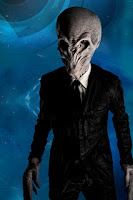I
took my daughter and her fiancée to the airport today at noon – it was too short a visit. I can’t
feel sorry for myself, though. The two of them see each other only once a
month or so; he is still at UC Riverside, and she's in Monterey, California. They need
a time machine, which is why, I suppose, they are such intense Dr. Who fans. Here's Jackie, on the right at a company Halloween party, dressed as Amy in "The Impossible Astronaut" episode about the Edvard Munch-inspired Silences.
The Silence has
a face that sticks in my brain like Hannibal Lector, the only movie character
I've ever had a nightmare about, unless I count the Teenage Zombies I saw when I was seven. The figure must have been in my mind when I glanced at a small photograph in a New York Times article on the WWII military carrier pigeon skeleton found in a Surrey, England chimney. Before I noticed the headline, I thought I saw the Silence figure lurking in the dark. If only the pigeon had been wearing a suit!
The pigeon's aren't the only battle-scarred bones to be unearthed lately. An intact human male skeleton was recently found at an archeological dig near the site of the Battle of Bosworth, where King Richard III died in 1485, and where he was reportedly buried. The skull showed trauma consistent with a sword wound, and a barbed metal arrowhead was wedged between two upper vertebrae. Most interestingly, a twist in the spine suggested scoliosis, which might have caused the living person to hold one shoulder slightly higher than the other: King Richard's famous "hunchback." DNA testing, to be complete in December, will give the definitive answer; the royal bloodline is of course alive and available for comparison today.
 |
| The site is apparently guarded by medieval knights! |
The hunchback is one of those theatrical signs of evil, something to be feared. It fits with Richard's character: conniving and power-hungry, willing to manipulate his subjects and even commit murder to gain the throne. At least that's the image we know from Shakespeare's play. It turns out that the evil king is about as real as all those ghosts in Richard's dream. In an interview on NPR's Morning Addition, Chris Skidmore, a current member of the British Parliament and author of Bosworth: the Rise of the Tutors, proposed that Richard III "had a very strong desire to promote the welfare of the poor and the ordinary people in his kingdom." He was apparently popular as well. The Tudors, who came to power upon Richard'd death, had an interest in discrediting the deceased monarch, and began a campaign of disinformation to help establish their legitimacy. Politics in 1485 was so different from now, right? If the DNA proves the royal lineage of the skeleton of Richard III, tradition may require the king to lie in state before his reburial. Let's hope it's not open casket.




